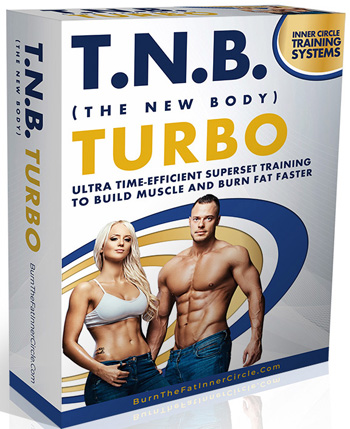How long you workout is not always the most important factor. How efficiently you use your gym time, how intensely you work, and how you progress from one workout to the next is more important. A 45-minute workout could actually give you more results than a 90-minute workout, if the shorter workout is done with more concentration, more effort, higher intensity and more diligent overload from week to week. With this in mind, we answer the question, “What are the most effective muscle-building workouts for busy people?
 QUESTION: Tom, I have limited gym time. If I get to the gym in my office building at my planned hour (7:00 am), I can fit in a 45 min workout with time left to shower, get dressed and take the three minute walk to my desk.
QUESTION: Tom, I have limited gym time. If I get to the gym in my office building at my planned hour (7:00 am), I can fit in a 45 min workout with time left to shower, get dressed and take the three minute walk to my desk.
I’ve been using a slightly modified workout from your Burn the Fat, Feed the Muscle book. For my first session I did only two sets, not three. That took only 45 minutes, so I figured it would take me just over an hour if I tried to do three sets of everything. If I stayed with two sets do you think I can still see results?
I have to keep the maximum gym time to 45 minutes. I can’t get to the gym any earlier (I won’t bore you with the details, but I have early morning commitments which mean that 7:00 really is the earliest I can get there. I have already “flexed my flex time” all I can. Do you have any other ideas on how to speed up a workout and still get good results, in this case, keeping it to 45 minutes?
ANSWER: Some athletes may need to train longer to be competitive or reach high-level goals, but for most general health and fitness goals, most people can get optimal or close to optimal results with 45 minutes.
All you have to do is design your program for time efficiency or modify an existing program using efficiency techniques and train hard.
You can create workouts that fit into any amount of time, within reason. If you only had 20 minutes, you could still squeeze in a good workout, with the right modifications. It might not be optimal, but it could still produce good results.
That leads me to my first suggestion: Avoid an all-or nothing attitude toward workout time and keep up your positive, can-do attitude that “some training is always better than no training.” Once you own that mindset, then if you are truly limited on time, simply make the most of it by choosing the time efficiency techniques that suit you the best. I’ll list several below.
There are several good time efficiency training methods, including reducing the number of sets per exercise, but the method I believe is ideal for getting workouts done faster, while still building strength and muscle effectively is superset training, so let’s look at that one first.
1. Use superset training.
A superset is a weight training technique where you perform two exercises in a row with little or no rest in between. After the second exercise, you take a short rest break, usually about 1 or 2 minutes, depending on the exercise. After the rest interval, you repeat the superset again for the prescribed number of sets – usually 3 supersets (6 sets total if you count both exercises).
The most common type of superset is the antagonistic muscle superset also known as paired set training or opposing muscle group superset.
For example, your hamstring muscles in the back of the thighs are opposite to the quadriceps muscles in the front of the thighs. An antagonistic paired superset for legs then would would be lying leg curl supersetted to leg extensions.
Your chest and back are opposite muscle groups as well. The bench press and barbell row superset is a famous example of a superset pair for chest and back.
The arms are tailor-made for paired supersets, with biceps on one side of your arm and the triceps on the other. The bicep curl to tricep extension superset has been a favorite of bodybuilders for years.
The shoulders don’t necessarily have an opposing muscle group, but since the deltoids are a three-headed muscle, you could simply to superset two shoulder exercises together, for different parts of the muscle (that’s a “same muscle group superset”). For example, an overhead shoulder press could be supersetted with a rear or side lateral raise with dumbells.
The abdominals could be paired with their opposite muscle group – the lower back (erector spinae or lumbar muscles) or you could also superset two different ab exercises, each one working a different part of the abdominal region or a different type of movement pattern.
The calves can be trained separately with regular sets, or they can be supersetted with other exercises, even if the muscle groups are unrelated (like calves supersetted with back).
You could actually superset any two exercises together, including completely unrelated muscles or the same muscle group. The opposite muscle group superset pair technique is simply one of the most popular, and it’s excellent for helping build strength as well as muscle.
Using this antagonistic muscle superset technique, you could take any standard weight lifting routine, such as the The New Body (aka “TNB”) routine found in the latest edition of the Burn the Fat, Feed the Muscle book, and you could change the whole workout into supersets. If there were 8 exercises before, each one done separately, now you have the same 8 exercises but they are done in 4 superset pairs. Here’s what it would look like:
Upper body
Exercise 1: Bench press
Superset to:
Exercise 2: Barbell Row
Exercise 3: Incline Dumbbell Bench Press
Superset to:
Exercise 4: Chin Ups
Exercise 5: Barbell overhead shoulder press
Superset to:
Exercise 6: Dumbbell side lateral raises
Exercise 7: Barbell Curl
Superset to:
Exercise 8: Lying Tricep Extension
Lower body and abs
Exercise 1: Squats
Superset to:
Exercise 2: Leg curls
Exercise 3: Leg press (or dumbbell lunge)
Superset to:
Exercise 4: Romanian deadlift barbell or Dumbbell
Exercise 5: Standing calf raise
Superset to:
Exercise 6: Plank
Exercise 7: Hanging leg raise or knee up
Superset to:
Exercise 8: Reverse crunch
Because all the exercises are performed in supersets with no rest in between each pair of exercises, this one technique alone could shave 15 -20 minutes off a typical one hour workout that was being done with traditional straight sets.
Note: I’ve nicknamed this workout “TNB TURBO” because it’s the same exercises and sets as our original TNB workout, but using supersets you get done faster.
2. Reduce rest intervals (but don’t eliminate them completely)
The second time-efficiency technique is simply to go through your workouts faster by shortening all your rest intervals between every set. Some people call this “density” training because you do the same amount of work in less time (or at least, that’s the goal).
For muscle building workouts, rest intervals are typically 1 to 2 minutes between sets. For strength workouts, the rest intervals are longer – sometimes 3 minutes or more. The reason for long rest intervals in strength training is because that allows the muscles to recuperate and recover more between sets so you can lift the most weight for the most reps.
To save time, if you were taking 2 minutes between sets, you can cut back to 90 seconds. If you were doing 90 seconds, cut back to 60 seconds. If you were doing 60 seconds, you could cut back to 45 or even 30 seconds.
You do have to keep in mind that if you make your rest intervals very short, you will finish your workout faster, but there is some compromise in strength. You can still get stronger from workout to workout, with short rest periods between sets, but don’t expect to develop maximum strength using this method, in fact, you may have to use less weight than usual at first because fatigue accumulates when you train this way. This shouldn’t matter if your training goals are general health, fitness and better body composition.
If you’re pressed for time and you’re not a strength athlete or powerlifter, then you don’t have to take long rest intervals between sets.
Here’s something else I’ve noticed: Certain types of people get bored out of their minds waiting around 2 or 3 minutes between sets, so the short-rest interval style of training not only makes the workout shorter, it’s more motivating and enjoyable for a lot of people who like to keep moving during a workout.
3. Reduce the number of exercises (but increase the bang for your buck)
Another time efficiency technique is to reduce the number of exercises you do. Some people call this “abbreviated” or “minimalist” training. It may be typical to do 8 or 10 exercises at every workout, but it’s not mandatory to do that many. You could do 5 or 6. You could even do just 3 or 4.
There are some benefits to accumulating a larger amount of volume (exercises and sets), especially for bodybuilding, but most people can get surprising good results with abbreviated routines that have fewer exercises, if you pick the right ones and work hard.
When you’re doing fewer exercises, the important thing is to focus only on the multi-joint, compound exercises that involve a lot of muscle mass and allow you to use heavier weights. Examples include squats, front squats, split squats, bulgarian split squats, lunges, chest presses, shoulder presses, rows, pull ups, deadlifts, romanian deadlifts, dips and challenging core-abdominal exercises.
These are known as “big bang for your buck” exercises because they are so hard to do and they put heavy demands on your body compared to isolation and single joint exercises like leg extensions, cable crossovers, bicep curls, tricep kickbacks or calf raises.
To allow yourself for some exercise variety over the course of the week, and to allow maximum recovery, you could also rotate two different workouts (or even three). This way you may in fact use 8, 10 or even more exercises each week, you simply don’t do them all on the same day.
Whether or not you added some additional work for small muscle groups like bicep curls or calf raises would depend completely on how much time you have. (Or you could even use the superset technique – for example, alternate your sets of abdominal exercises with calf raises – you can combine techniques!)
Here’s an example of a full body workout, which would be done three days per week. Workouts A and B would be rotated for variety. Sets and reps would be the same as usual, there are simply fewer exercises.
Full Body Workout A
Exercise 1: Deadlift
Exercise 2: Bulgarian Split squat
Exercise 3: Military Press
Exercise 4: Dips
Full Body Workout B
Exercise 1: Squats
Exercise 2: Chin Ups
Exercise 3: Bench Press
Exercise 4: abs/core
Here’s an example of an abbreviated 2 day split routine that only uses the big bang for your buck exercises. This could be done three or four days per week. Sets and reps would be the same as usual, there are simply fewer exercises.
2-Day Split, workout A
Exercise 1: Bench press
Exercise 2: Chin Ups
Exercise 3: Military Press
Exercise 4: Dips
2-Day Split Workout B
Exercise 1: Squats
Exercise 2: Romanian Deadlift
Exercise 3: Walking Lunges
Exercise 4: abs/core
Exercises may be substituted based on your experience or fitness level and equipment available. For example, if you’re a beginner, or you don’t have a squat rack or barbell, you could do goblet squats holding one dumbbell.
Let me circle back briefly to my comment about avoiding “all or nothing thinking” when it comes to training duration (or volume). I want to point out that if you really had to, you could cut each workout down to 1 or 2 exercises. On leg day if you did nothing but squats and one hamstring or hip-dominant exercise but you worked those squats really hard, you have achieved something. And on back day if you did nothing but deadlift or bent over row or pull ups and you work out super hard, again you have accomplished something significant with very little time invested.
4. Reduce the number of sets (but increase intensity)
The fourth time efficiency method is to keep the same exercises but to reduce the number of sets you perform from the typical 3 or 4 to only 2 or 3. I probably wouldn’t recommend this as your first choice – the superset, reduced rest interval and abbreviated schedule techniques are more effective for time saving while keeping up training volume. However, reducing sets is definitely another option.
I don’t recommend taking this to the extreme and adopting the “one set to failure” method. This topic has been debated for decades, and while we know it’s possible to get some results with one set if the intensity is high enough, the most recent research suggests that multiple sets are superior.
If you decide to reduce your sets, the key to making it work without compromising your results is to to make every set count. The intensity level of each set should be higher than if you were doing more sets and you may benefit from pushing more sets to failure.
5. Circuit Training (Pros and cons)
There is a 5th method of speeding up your weight training workouts, and that is circuit weight training, but it does have pros and cons. Circuit training is often the first technique to come to many people’s minds when it comes to time-saving workouts, especially among the general fitness crowd. It is not popular among bodybuilders and strength athletes.
These days, circuit training is more often referred to as “metabolic weight training,” and the science of circuit training has advanced quite a bit. There are some major differences between classic circuit weight training and modern metabolic weight training that the top trainers are recommending today.
The old style of circuit training would typically have you perform 8 to 10 exercises in a row one after the other, non stop with little or no rest between each exercise. At the end of the 8-10 exercises, you would rest briefly and then repeat the circuit 1 or 2 more times.
Because it’s difficult to do this in a crowded gym, you would often see a circuit training room that had 10 machines lined up in a circle or in rows that you would work through from station to station in order.
Most modern methods of metabolic weight training are similar in concept, but usually use 3 to 5 highly demanding large muscle group, compound exercises, all in a row, which you would then repeat several times. Some people call these mini-circuits.
Here’s an example of a 4-exercise metabolic circuit:
1. Pull up (upper body pull) or inverted row
2. Bulgarian split squat (lower body quad dominant)
3. Overhead Push press (upper body vertical push)
4. Romanian deadlift (lower body hip dominant)
(Note: An abdominal or core exercise might be added onto the end of circuit.
To do a through job explaining metabolic weight training would take another article, and in fact, there are entire books and courses written about it. This is simply an introduction to the concept, and you may want to dive deeper if these ideas appeal to you.
Before you decide to switch from traditional weight training to circuit training or metabolic training, however, you should give serious consideration to your goals.
If your primary goals include general fitness, conditioning, muscle “tone” and health, and you’re not concerned with maximum strength or maximum muscle size, then metabolic or circuit training can be a good choice that’s compatible with your goals and fantastic for saving you time, since these workouts have you moving almost nonstop and don’t take long to complete.
On the other hand, if your primary goals include gaining strength or gaining muscle size, then metabolic or circuit training is not the ideal choice, and I would recommend different techniques for time efficiency, especially the antagonist superset method (as seen in THE NEW BODY TURBO).
I’m not against circuit training, but if building muscle and strength are important to you, then you don’t want to compromise your strength training workout by trying to turn it into “cardio with light weights.” That’s what circuit training sometimes is, the way I see it, and that’s why serious bodybuilders, powerlifters and strength athletes don’t do it much.
Wrap Up
Everyone’s goals are different, but strength and muscle building are important aspects of fitness, so I believe that everyone should lift weights (or do some form of resistance training). For best all around fitness, that should include a dedicated, pure form of resistance training where you lift weights that are at least moderately heavy for optimal development of strength and muscle. Then in separate workout, do your dedicated cardio training for calorie-burning, fat loss and conditioning.
This is the basis of the Burn the Fat, Feed the Muscle system of body transformation and fitness. There are four elements in the program and two of them are training – one is resistance training and one is cardio training. If you’re going to do both types of training separately, then time does become a consideration, but fortunately, time efficiency techniques like supersets don’t require you cut your poundage down very much compared to circuits.
So give these these methods a try. Start including supersets, or reduce your rest periods between straight sets slightly and see what happens. If you need to condense further, then consider reducing the number of exercises or sets, but when you cut the workout volume lower, be sure to bump up the intensity level higher and you should still see some fantastic results.
Check back here on Burn the Fat Blog every week for the latest updates.
Train hard and expect success,
Tom Venuto,
Author of: Burn The Fat Feed The Muscle
Creator of The New Body (TNB) Turbo
IS FAT LOSS YOUR #1 GOAL? Burn the Fat, Feed the Muscle is the classic “bible of fat loss,” based on the tested, proven methods of bodybuilders and fitness models. The new edition is now available in hardcover, as well as in the popular audiobook format here: https://amzn.to/2pCG7lX
IS BUILDING MUSCLE IN LESS TIME YOUR #1 GOAL? If so, The New Body (TNB) TURBO is the program for you: Ultra-time efficient “superset” training proven by science to build muscle in 50% of the time. To learn more CLICK HERE







I found your answer really useful, thanks!
Thanks. Happy to hear it was helpful.
How many sets do you do and reps for the TNT Workout.
Hi Chris. I recommend 3 sets per exercise for TNB workouts. You could bump it up to 4 sets as a method of progressive overload, but of course, that takes longer and the idea of the TNB TURBO workouts that use supersets is time efficiency, so most busy people stick with 3 sets
I recommend 8 to 12 reps for hypertophy day workouts and 4 to 6 reps for strength day workouts typically. However, my new training system suggests 6 to 10 reps on heavy day and 12 to 15 reps on lighter day.
I believe you’ll get better results and there are many many advantages of using this “undulating” rep system instead of only using one rep range.
Example:
4 days a week schedule:
Monday: strength day upper body (lower reps, heavier weight)
Tuesday: strength day lower body (lower reps, heavier weight)
Thursday: hypertrophy day upper body (medium/higher reps)
Friday: hypertrophy day upper body (medium/high reps)